Column-Inflation Narrative A 'Virus' And Policy Headache: Mike Dolan
Central banks risk losing the battle for stable prices as long-dormant inflation narratives and memories reawaken, adding a more complex psychological twist to task than simply tightening monetary policy.
Far from being solely an excess money thing, as strict monetarists insist, many economists reckon the return to a high inflation regime relies as much on shifting popular narratives that entrench expectations and change the behaviour of households and businesses.
And this changed behaviour - in wage bargaining, corporate price setting or even government indexation of spending - feeds and embeds the rise in inflation over time. This is the 'de-anchoring' of expectations central banks claim to fear most.
Because that dominant narrative is typically shaped in the media - both traditional newspapapers, broadcasters or online news as well as social media or digital forums - monitoring the themes of what hits the headlines becomes a valuable tool.
And the speed with which that narrative can change now in a world of such rapid-fire and ubiquitous media is much faster than when inflation was last this high - four decades ago.
If it was only about money supply, you might have expected near zero interest rates and central bank money printing for the past decade to have had more than the modest flicker it had on core inflation rates. And yet all that money appeared to have ended up in financial assets instead - chasing neither wages nor consumer prices higher.
But a jolt from the pandemic followed by the more recent energy price shock has shifted the dial for the first time in decades.
Amundi Institute Chairman Pascal Blanque has for years studied the role of changing media narratives in enhancing purely numerical economic and investment models and insists his long-standing belief that we're heading "back to the 1970s" high inflation regime is backed up by that analysis.
These changes can happen suddenly and exponentially, he reckons, as short-term memories connect spiking inflation rates of the past year with long-term memories of past inflationary eras. That process is already happening and it's likely too late for the central banks to put a lid on it - even if they want to.
"Narratives play a role in spreading inflation exponentially like a virus, turning it into a mass phenomenon with feedback loops and self-fulfilling prophecies," he said, adding that artificial intelligence allows us to analyse them more easily.
"People form expectations in the same way that they remember and forget," he said, referring to what he called a "coefficient of forgetfulness" that moves higher the further you get away from an episode or shock but then can change suddenly, with media acting as an reminder and 'accelerator'.
Amundi chart on GDELT news searches
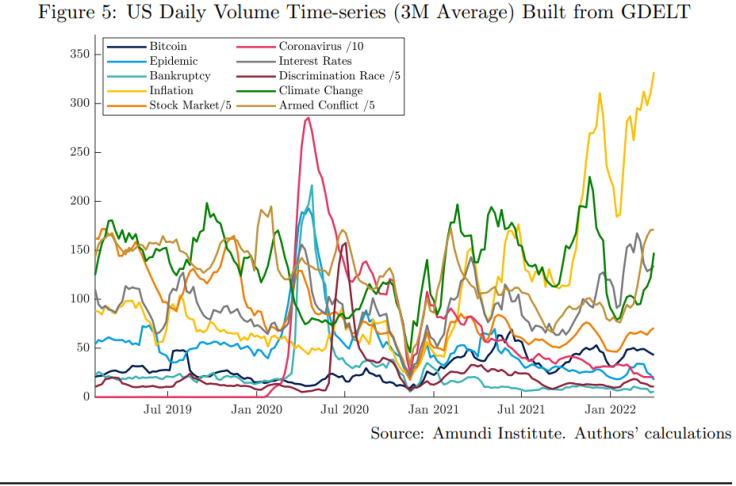
ASR chart on inflation in earnings calls
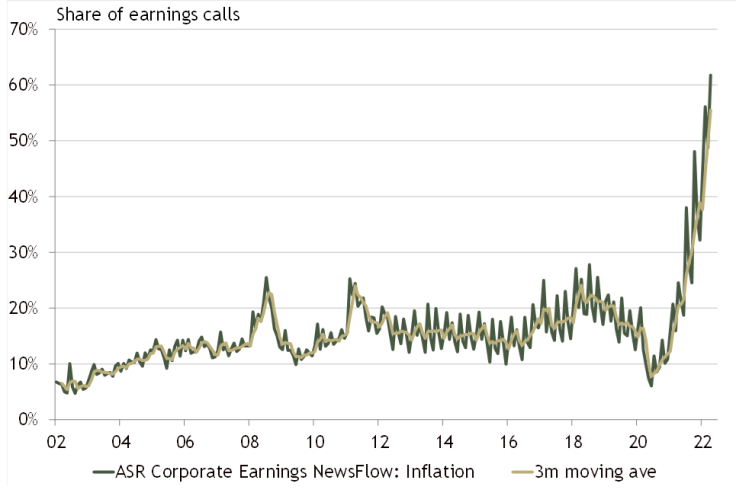
Headline inflation over 50 years
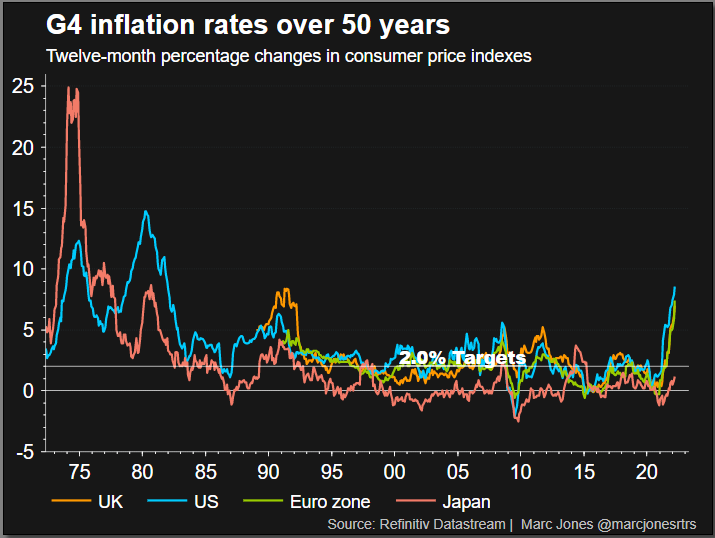
'COEFFICIENT OF FORGETFULNESS'
Blanque's team used the Google-based collaboration GDELT - or the Global Database of Events Language and Tone - to monitor this newsflow worldwide. These clearly showed the daily volume of inflation 'identifiers' more than doubling over the past year and exceeding the peaks of the COVID equivalent in March 2020.
What's more, constructing broader themes from these searches showed that rankings dubbed 'Roaring 20s' or 'Back to the 70s' or 'Geopolitical Risk' consistently exceeded competing narratives such as 'secular stagnation', which characterised the world economy for the decade after the banking crash of 2008.
Other researchers that monitor news sentiment closely find something similar. Economists at Absolute Strategy Research say their global inflation newsflow monitor is a pretty good fit with 10-year inflation expectations in the bond markets and is at its highest in least 20 years.
ASR also points to soaring mentions of inflation in corporate earnings calls - the highest in at least 20 years and more than three times the share of calls that fell into that category at the start of last year.
But is this much different to what we are already seeing in monthly inflation reports themselves or more prosaic readings of market-based inflation expectations and consumer surveys?
Inflation-expectations captured by 'breakevens' from the inflation-protected 10-year U.S. Treasury bond briefly topped 3% last week for the first time in 25 years before slipping back.
The University of Michigan's household inflation expectations survey has a 1-year outlook above 5%. But that's still below the prevailing rate of core inflation and expectations slip back to 3% over a 5-year horizon.
These are far from the 10%-plus inflation rates of 1970s.
But Amundi's Blanque thinks the scale of the public narrative shift means this is just the start and US inflation of 4-5% was now a more likely scenario over the years ahead.
He feels central banks are deliberately 'behind the curve' on inflation, will remain so even as they tighten policy ahead and may well avoid recession in the process.
Along the way, they and their governments will be tempted by the positives of higher inflation in generating higher nominal wage and output growth and inflating away debts.
The biggest casualty may be what he called the "great monetary policy consenus" among central banks in favour of patchwork of different approaches and a crisis of orthodoxy.
University of Michigan consumer inflation survey

Markets' inflation expectations
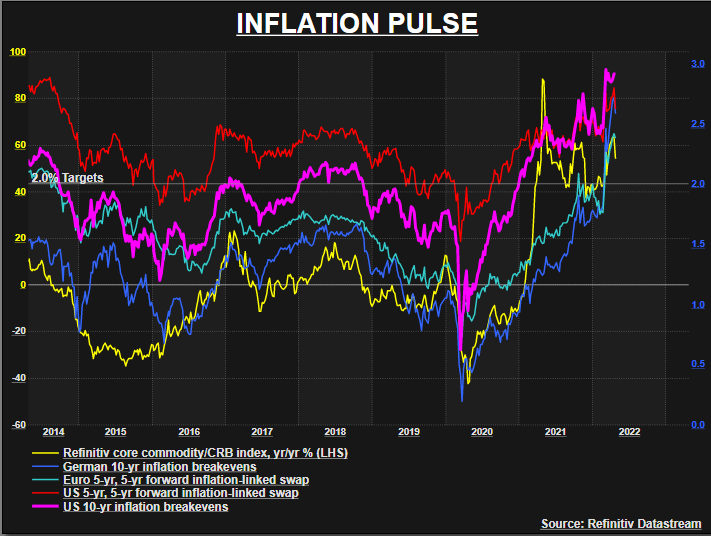
G4 central bank balance sheets
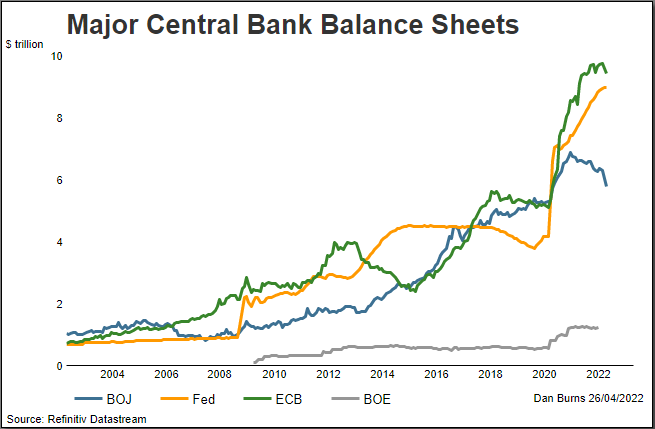
Related columns:
COLUMN-Felling the 'magic money tree' as central banks call time :Mike Dolan
COLUMN-Wage-price spiral alarm risks prolonging real income funk: McGeever
The author is editor-at-large for finance and markets at Reuters News. Any views expressed here are his own.
(by Mike Dolan, Twitter: @reutersMikeD; Editing by Chizu Nomiyama)
© Copyright Thomson Reuters 2024. All rights reserved.




















